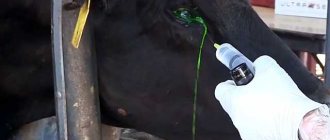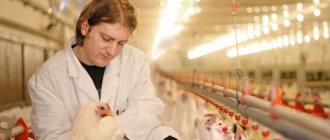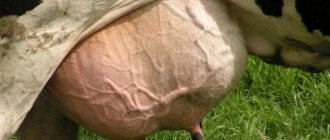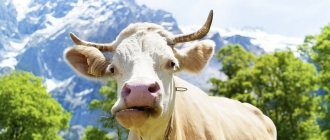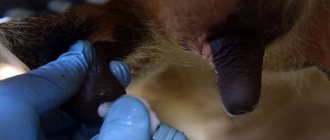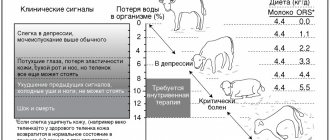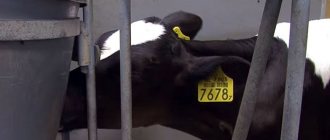» Livestock » Cows and bulls » Sore in calves and cows
0
2942
Article rating
Cows are strong and resilient animals. If they are properly maintained and their diet is followed, they are rarely susceptible to disease. Walleye in calves and cows is a common disease that affects the eyes of the animal. To treat it, it is necessary to start therapy in a timely manner.
- Conclusion
Cow's thorn
Why do cows have cloudy eyes?
Cows' eyes can become cloudy for a variety of reasons. One of the most common is keratitis or inflammation of the cornea, as a result of which the lens noticeably darkens and profuse lacrimation occurs.
The following reasons are also identified:
- Mechanical damage. This means a scratch of the mucous membrane near the eye, an injection or bruise with work equipment or the horn of another animal.
- Thermal damage. A cow may burn herself on something or be burned while treating an eye condition after being treated with a liquid that is too hot.
- Chemical damage. A cow's eyes may become cloudy after burns caused by various drugs if higher dosages have been used.
- Physical damage. Cloudy eyes in a cow are often evidence that lime dust has reached the mucous membrane.
- Infectious diseases. They are often the reason why a cow develops an eyesore.
Cloudiness of the eyes is expressed primarily in the loss of shine of the cornea. Then it acquires a smoky shade, gradually turning into white. This is a symptom common to a number of eye diseases, including eyesore, but it also has its own specific features.
Causes and signs of the disease
The cause of the development of the disease can be a number of factors:
Sometimes leukoma is of the nature of a congenital pathology. This is possible when a pregnant female suffers from inflammatory or infectious diseases.
Depending on the nature of its occurrence, the disease has a number of characteristic signs, the main of which is the periodic or persistent presence of a cloudy lesion on the eye of the animal.
Upon visual examination of the cornea, its uneven surface is clearly visible. The damaged top layer of the shell forms a gray-yellow film, which is easily removed and appears again after a while. In severe cases of the disease, the damaged surface of the eye becomes very thin and the cataract protrudes outward, forming a convex hemisphere.
Signs of an eyesore in a cow
As additional symptoms of eyesore in a cow, the following changes in physiology and behavior are noted:
- Profuse lacrimation, which is accompanied by the onset of inflammatory processes in the nasopharynx.
- Photophobia and inflammation of the capillaries. The animal tries to go into the shadows, behaves quite restlessly and even aggressively, which is associated with painful sensations in the eye. When the disease begins, the cow begins to constantly moo from the discomfort she experiences.
- A sharp decrease in visual acuity - the animal suddenly begins to have difficulty oriented in space, staggers from side to side, and moves slowly. The gait of a sick cow becomes cautious.
- The cow constantly shakes or simply moves its head, and to the same side - the one where the healthy eye is located. This is explained by the fact that the animal’s viewing angle is reduced.
- If the eyesore is not treated in time, the disease progresses to an acute stage - blood clots appear on the cornea, the mucous membranes become red and swollen. The swelling also affects the upper eyelid, as a result of which the cow’s eye sometimes closes completely.
- Another sign that the disease is already at an extreme stage is the appearance of serous-purulent discharge around the cataract. With severe hyperemia, the cow's eye noticeably protrudes.
Important! You should not delay treatment of the disease and hope that the inflammation will go away on its own. At the first sign of an eyesore, you need to call a veterinarian to examine the cow and prescribe medication.
Symptoms
The development of the cataract occurs gradually. Immediately after an organ is exposed to a negative factor, a small spot appears and is difficult to see.
To determine the disease in a calf or adult animal, the following signs are used:
- constant release of liquid from the apple;
- symptoms of conjunctivitis, the appearance of ulcers on the organ, sticking of the eyelids;
- high pupil sensitivity;
- poor tolerance to bright light;
- swelling;
- the appearance of red spots.
Causes of eyesores in cattle
An eyesore in a cow can occur for a variety of reasons:
- Most often, corneal scarring begins due to mechanical damage. They can be caused by any small but fairly hard particles - sand, lime dust. Inflammation can also be triggered by a scratch or prick from a small branch that the cow stumbled upon while looking for food.
- Sometimes an eyesore indicates the presence of an infectious disease in the cow's body.
- Quite often, a cow's eyes become cloudy after suffering from conjunctivitis or an ulcer.
- Human factor can also cause eyesores. This occurs due to improper treatment of other eye diseases, if too concentrated or hot solutions are used.
- Another widespread cause of the disease is thelaziosis. It is expressed in infection with helminths after flies lay eggs on the edge of the cow's eye. Small worms soon hatch from them, which cause inflammation of the cornea.
Sometimes eyesores are hereditary. In small calves, it is detected if the cow has experienced a helminth infection during pregnancy, which is transmitted to the fetus. These calves grow poorly and are often born prematurely. Timely vaccination of pregnant cows helps reduce the risk of catarrh in calves.
Reasons for appearance
To understand what an udder abscess is, you need to know for what reasons the disease begins. Most often it occurs after purulent catarrhal mastitis. In some cases, the disease may be a consequence of an inflammatory process in the genital or other organs of the cow. Ulcers can arise from incorrectly placed injections, as well as bruises and various types of injuries.
When the inflammatory process begins in the mammary glands of a cow, cavities form in them, in which pus accumulates. If there are several abscesses, they can connect so that the affected area increases significantly.
It is not so easy to immediately see inflammation in the udder, because most often the abscess begins not on the surface of the mammary glands, but deep inside. But what makes the disease dangerous is that when the abscesses mature, they can burst, and the fluid accumulated in them ends up in the milk ducts.
Attention! During milking, pus gets into the milk, making the product unsuitable not only for humans, but also for calves.
Real owners who care about the health of their pets find it difficult to look at sick animals. If you have the above symptoms, you should call a specialist. It is important not to delay treatment, as pus from the cavity enters the blood and can be fatal.
Unfortunately, in many rural areas there are no veterinary hospitals, so help cannot be started right away. A specialist who does not have the opportunity to immediately go to the farm will give recommendations, and the owners must independently provide pre-medical assistance.
Until a veterinarian arrives to examine the sick cow, the owners must take care of it.
To do this, you need to place the cow in a separate stall and lay down fresh bedding. Then, if the cow is not aggressive, apply lotions to the inflamed area. They are applied until the seal becomes soft.
You can make hot lotions for treating cows yourself:
- From dust from hay, bran, sawdust. These ingredients are steamed with boiling water, cooled slightly and applied to the sore spot.
- Lotions made from alcohol or ozokerite (mountain wax) help well.
- If there are medicinal muds in the area, then before use they need to be heated to a temperature slightly above room temperature and applied to the udder of cattle in case of an abscess.
Until the veterinarian arrives, it is advisable to feed animals with an abscess a few Sulfadimezin tablets along with liquid food to reduce the inflammatory process. The number of tablets will be indicated by the doctor, as it depends on the body weight of the cattle.
It is not recommended to carry out any cold compresses or massages on the cow’s udder, since such procedures can provoke the migration of harmful microbes throughout the body.
Veterinarian help
Arriving at the farmstead, the doctor carefully examines the cow. Depending on the condition and form of the cattle abscess, he makes a decision on treatment.
Treatment of this disease is a rather labor-intensive and complex process. The infection instantly spreads throughout the body and leads to irreversible changes.
Therefore, the main therapy often consists of two specific courses, one of which is aimed at eliminating pathogenic bacteria from organs and tissues, and the other at treating symptomatic manifestations.
For antimicrobial therapy of leptospirosis in livestock, a fairly impressive list of various drugs is used.
We suggest you familiarize yourself with: Types of predatory aquarium fish
Among them, the most effective is therapy based on the following means:
- hyperimmune serum - injected into the body in the form of subcutaneous injections 1 or 2 times at the rate of 1 ml/kg of animal weight;
- streptomycin - used as a subcutaneous injection at a rate of 10–12 thousand units/kg of animal weight, every 12 hours. The general course of treatment with streptomycin is no more than 5 days;
- kanamycin - the drug is administered intramuscularly at a rate of 15 units/kg of animal weight. Use it for 5 days with an interval of 8 hours between each use;
- tetracycline - administered to animals orally, with food or water. It is used twice a day at a dose of 10–12 mg/kg body weight. General tetracycline therapy lasts until complete recovery.
To alleviate the symptomatic manifestations of leptospirosis, sick animals are shown:
- Ringer-Locke fluid - the drug is administered intravenously at a rate of 3 l/individual per day;
- hemodez - introduced into the body intravenously, by drip, 1–2 times a day, at a rate of 500–1000 ml/individual (for calves, the dosage is reduced by 10 times);
- syntomycin - given to livestock orally, 3 times a day, at a dose of 30 mg/kg body weight. The duration of therapy is no more than 4 days;
- caffeine benzoate - used for intramuscular injections, at a rate of 5–10 ml/individual. The duration of therapy and the number of injections are prescribed by the veterinarian individually;
- glucose solution (40%) - used as intravenous injections at a rate of 200–500 ml/individual per day (less for calves, more for adults).
Important! When treating cattle for leptospirosis, it is imperative to adhere to general safety measures when working with infected animals, since the disease is extremely dangerous for humans.
There are quite a few reasons why an eyesore may appear. Most often it is provoked by injury to the delicate tissues of the cornea, the ingress of some small particles or contamination of the same injured tissue. This happens quite often, since when a foreign object enters and is removed from the eye, the normal healing process begins - at the site of injury to the cornea, connective tissue grows, which grows, causing opacities.
Did you know? Cows sense the Earth's magnetic field and sense when it changes. When eating food or resting, they place their body exactly along its lines.
Also, a thorn may appear after inflammation, such as conjunctivitis or ulcers. In this case, a scar appears. Sometimes a cataract arises from improper treatment, for example, washing with some active chemical component that burns the cornea and causes clouding. Thelaziosis is a common disease that causes vision problems.
Appears as a result of helminth infection. They usually enter through flies - they sit on the edge of the eye and begin to lay eggs, from which small worms emerge. They attack the cornea and penetrate inside, causing an inflammatory process, keratitis, which causes decreased vision. Sometimes the thorn can be generic.
How to treat a cow's eyesore
If an eyesore is detected on a cow, it is not recommended to independently treat the animal. Medications should be prescribed by a veterinarian, and traditional methods of treatment should in no case replace them entirely. They can only act as auxiliary means.
Important! Treating eyesores in cattle is a long and quite difficult process. Full recovery occurs on average after 1-1.5 months.
Drug treatment of eyesore in cattle
Drug treatment may include the use of the following medications:
- 1% solution of "Chlorophos". Rinsing the affected eye is carried out according to a doctor’s prescription, the recommended frequency of procedures is 3-4 times a day. If inflammation is severe, this amount is increased to six times a day. Sometimes, instead of rinsing, the veterinarian may prescribe injections behind the third eyelid.
- Tetracycline ointment. It is applied to the eyelids as an independent treatment 2-3 times a day or lubricated at the injection site after using the Chlorophos solution.
- "Albendazole". The veterinarian prescribes this remedy if the eyesore appears as a result of helminth infection. It is applied once at the rate of 1 ml per 10 kg of cow weight.
- Iodine solution. This remedy is used against thelaziosis, which causes the appearance of an eyesore. 1 g of crystalline iodine must be mixed with 2 g of potassium iodide and diluted in a glass of boiling water. When the solution has cooled, it is drawn into a special syringe or syringe and the eye is treated, while the stream should be directed to the inner corner.
- 0.5% carbolic acid. To wash the cataract, a small amount of carbolic acid is diluted in 200 ml of water. The exact dosage and frequency of washings is prescribed by the veterinarian.
- 3% boric acid solution. This remedy is also used against helminths. The solution is drawn into a syringe and washed out the sore eye of the cow.
Treatment should be systematic and constant; skipping even one procedure is undesirable. It is important to follow all the doctor’s instructions exactly, otherwise the treatment of the cataract will last for many months.
Folk remedies for cow eyesores
Powdered sugar is very popular against eyesores, which is explained by the effectiveness and low price of this folk remedy. It’s very simple to make – just pour granulated sugar into a coffee grinder and grind it to a powder. This will take some time, because large particles of sugar can only make the situation worse.
You can use powdered sugar in two different ways. The first is to gently blow the powder onto the eyesore. The second involves diluting powdered sugar in water, but there is no need to completely dissolve it - the result should be a viscous mass, which is applied to the sore eye like an ointment. Some farmers prefer to place it under the cow's lower eyelid.
It is necessary to treat a cow's eyesore 4-5 times a day. Powdered sugar effectively copes with the symptoms of the initial stage of the disease - the thorn becomes smaller in size and fades already on the fifth day, however, the powder cannot completely cure the inflammation. This requires full-fledged drug treatment, and sometimes surgical removal of the cataract may be required.
Advice! Lotions made from dandelion infusions have proven themselves to be effective in treating eyesores.
Drug treatment
How to treat a cow's cataract so that the animal recovers faster? If traditional treatment methods do not produce results, you need to use special medications. The eye on which the stain appears should be washed with a 1% chlorophos solution. Washing should be done according to the instructions or in agreement with the veterinarian. This solution is administered in a dosage of 3 - 4 ml for the third eyelid. Tetracycline ointment can then be applied.
Please note that the disease must be treated systematically, since eye inflammation does not go away quickly.
Some farmers treat eye diseases in cattle for 2-3 months. But it is not enough to simply treat inflammation; you need to identify the cause of the cataract, for this the veterinarian must take tests. If the cause is worms, then it is necessary to carry out treatment for parasites.
Preventive actions
You can significantly reduce the risk of eyesores with a number of simple recommendations:
- The barn must be kept clean and tidy. The bedding is changed regularly, and the room where the cows are kept is ventilated. Also, there should be no potentially dangerous objects in the barn, due to which animals can suffer eye injuries and, as a result, eyesores. Manure is removed in a timely manner, as it attracts flies, and they, in turn, become the cause of thelaziosis, which is also fraught with the appearance of cataracts.
- Pastures for grazing cows are chosen so that they are located as far as possible from forests. This will reduce the likelihood that the cow will accidentally injure her eyes on small branches while looking for food and provoke the development of cataracts.
- Vaccination should not be neglected under any circumstances. All recommended seasonal vaccinations must be completed, including for pregnant cows. This will reduce the possible cause of the eyesore due to the fact that the likelihood of getting an infection will decrease.
- From time to time, to prevent eyesores, you should cleanse from parasites, at least once a year. This is usually done in the spring or summer with the help of drugs such as Alvet, Tetramizole and Albendazole. Antiparasitic agents are carefully diluted in water and added to drinking bowls or feed.
- Cow skins are periodically treated with various medications against flies, ticks and horseflies. For these purposes, such products as “Aversect”, “Entomozan” and “Sebacil” are suitable. The recommended dosage is 1 ml of the drug per 100 ml of water. The resulting solution is taken into a spray bottle and sprayed on the cows.
Advice! Additionally, visual inspection of animals should be carried out at least once a week. This way, signs of an eyesore can be detected early while it is still in its early stages, which greatly simplifies the treatment of the cow.
Prevention
It is more difficult to cure a disease than to prevent it in time, so it is very important to follow all the rules for the care and maintenance of cows. The sooner you start treating inflammation, the fewer consequences there will be for the animal and the farmer. In advanced cases, the appearance of spots on the eyes can lead to the development of other diseases.
If your animal has been diagnosed with any disease, such as keratitis or infectious conjunctivitis, it must be treated immediately to avoid complications.
Check and inspect your herd daily. Conduct a detailed inspection of the animals every week.
To detect the disease in time, you should observe the behavior of your animals. If any problems arise, the cow’s body will react to this, perhaps the mood or appetite will change. Keep the pen clean and do not leave sharp objects in a visible place, as the animals can get hurt and thus introduce dirt.
